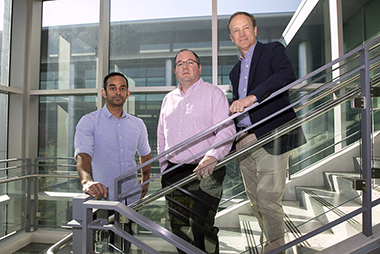Researchers Target Toxic RNA for Clues to Subdue Myotonic Dystrophy
 |
|
RNA Institute researchers, left to right, Kaalak Reddy, John Cleary and Andrew Berglund pose in the Life Sciences Research Building. (Photo by Patrick Dodson) |
ALBANY, N.Y. (Nov. 21, 2019) — Newly published research by RNA Institute faculty may reveal clues for ways to treat a devastating neuromuscular disease.
This recent work by Professor Andrew Berglund, director of the RNA Institute, and two new Institute scientists, John Cleary and Kaalak Reddy, seeks to identify drugs that would reduce the toxic RNA molecules that cause myotonic dystrophy (DM), the most common adult form of muscular dystrophy. Their study was recently published in the journal Proceedings of the National Academy of Sciences of the United States of America.
Myotonic dystrophy affects not only a patient’s muscles but also their brain, heart, eyes and GI tract. There are two forms of the disease, type 1 (DM1) and type 2 (DM2), that share similar symptoms and are caused by expansion of a small segment of the human genome that is repeated hundreds to thousands of times in patients.
When the DMPK gene in DM1 or the CNBP gene for DM2 are made into RNA messages to produce proteins, the presence of the expansion in the RNA disrupts normal cellular function, leading to disease. [See Science Background at bottom of story.]
“Despite the discovery of the genetic cause of these diseases more than two decades ago, there are currently no treatments available for patients suffering from myotonic dystrophy,” said Berglund. “My work with Drs. Cleary and Reddy is designed to find such treatments.”
A New Cell Line for a New Class of Drugs
To identify drugs that could potentially target the toxic RNA in DM, the researchers engineered a new cell line that mimics the disease. “This cell line produces a toxic CUG RNA with a marker that can be precisely and easily measured following drug treatments,” said Reddy. “These cells also produce a partner non toxic RNA that is also marked which can be measured in parallel to identify drugs that selectively target only the toxic RNA.”
Using this new cell line, the three researchers screened hundreds of compounds, several of which are FDA-approved, eventually leading to the identification of a new class of drugs that selectively reduce the toxic CUG RNA burden in DM1 patient cell lines and in a DM1 mouse model.
This powerful DM1 screening cell line is currently being used in large-scale screens of thousands of available drugs from the National Institutes of Health (NIH) repositories and from industry partners, said Cleary. “Application of this new screening approach may lead to the identification of new drugs that can help patients and families affected by this neuromuscular disorder.”
Decades of Myotonic Dystrophy Expertise
For more than 18 years, Berglund has focused a good deal of his research on understanding the mechanisms of DM, as well as other microsatellite diseases such as ALS. Reddy has been investigating repeat expansion disorders for more than a decade with a focus on DM since his PhD studies in molecular genetics at the University of Toronto. For almost two decades, Cleary, like his colleagues, has focused on DM and other repeat expansion disorders, with his recent attention aimed on translating these findings towards therapeutic benefit to patients.
Together with other scientists at the RNA Institute, this trio is helping to bring a new focus on subduing myotonic dystrophy and other repeat expansion diseases.
Science Background: The human genome is made up of millions of different combinations of the same four basic building blocks, or nucleotide bases: Adenosine (A), Cytosine, (C), Guanine (G) and Thymidine (T). When a cell wants to make a protein, it makes a copy of those building blocks, called ribonucleic acid or RNA, to provide instructions for the protein machinery. In making this copy, the cell uses a different building block called uracil (U) instead of thymidine (T). In myotonic dystrophy type 1, the same sequence of building blocks — cytosine-thymidine-guanosine (CTG) or, for RNA, cytosine-uracil-guanosine (CUG) — are mistakenly repeated hundreds or thousands of times, such as when a person stutters while speaking.
![]() For more news, subscribe to UAlbany's RSS headline feeds
For more news, subscribe to UAlbany's RSS headline feeds
A comprehensive public research university, the University at Albany-SUNY offers more than 120 undergraduate majors and minors and 125 master's, doctoral and graduate certificate programs. UAlbany is a leader among all New York State colleges and universities in such diverse fields as atmospheric and environmental sciences, business, education, public health,health sciences, criminal justice, emergency preparedness, engineering and applied sciences, informatics, public administration, social welfare and sociology, taught by an extensive roster of faculty experts. It also offers expanded academic and research opportunities for students through an affiliation with Albany Law School. With a curriculum enhanced by 600 study-abroad opportunities, UAlbany launches great careers.


